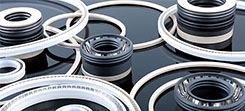Understanding the Types of Springs in Spring-Energized Seals
Spring-energized seals are a crucial component in many high-performance applications, providing reliable sealing under a variety of conditions. The type of spring used in these seals plays a significant role in their performance and suitability for different applications. This article delves into the different types of springs used in spring-energized seals and their specific characteristics and applications.
1. Cantilever Springs
Characteristics:
High Load Capacity: Cantilever springs are designed to provide a high sealing force, making them suitable for applications where a significant load is required.
Durability: These springs are robust and can withstand substantial deformation without permanent set or fatigue.
Applications:
Static Applications: Cantilever springs are ideal for static applications where the seal does not move relative to the mating surface. Examples include flanges and stationary equipment.
Slow Dynamic Applications: They are also used in slow-moving dynamic applications where minimal movement occurs, such as in some hydraulic and pneumatic systems.
2. Helical Springs
Characteristics:
Balanced Load Distribution: Helical springs offer a more evenly distributed load compared to cantilever springs, providing consistent sealing force.
Flexibility: They can accommodate both radial and axial movements, making them versatile in their applications.
Applications:
Dynamic Sealing: Helical springs are commonly used in dynamic applications where the seal needs to accommodate movement, such as in rotating shafts and reciprocating pistons.
Versatile Uses: Their ability to handle various movements makes them suitable for a wide range of industrial applications, including automotive.
3. V-Springs
Characteristics:
High Resilience: V-springs are known for their high resilience, allowing them to maintain a consistent sealing force over a wide range of temperatures and pressures.
Versatility: These springs can be used in both static and dynamic applications, providing reliable sealing performance.
Applications:
High-Temperature Applications: V-springs are ideal for environments with extreme temperatures, both high and low, making them suitable for cryogenic applications.
Pressure-Intensive Applications: They perform well in high-pressure environments, such as in oil and gas equipment and hydraulic systems.
Selecting the Right Spring for Your Application
When choosing a spring-energized seal, it is essential to consider the specific requirements of your application, including the type of movement (static or dynamic), operating temperature, pressure conditions, and chemical environment. The right spring will ensure that the seal performs optimally and maintains its integrity over time.
Conclusion
Understanding the different types of springs used in spring-energized seals is crucial for selecting the right seal for your application. Cantilever springs provide high load capacity for static and slow dynamic applications, helical springs offer balanced load distribution for dynamic applications, and V-springs deliver high resilience for extreme temperature and pressure conditions.
Kaflon (Xiamen) Seal Co., Ltd. is dedicated to providing high-quality spring-energized seals tailored to meet the specific needs of various industries. For more information about our spring-energized seal products and to discuss your application requirements, please contact us.


 Resources&Tools
Resources&Tools
 Resources&Tools
Resources&Tools






